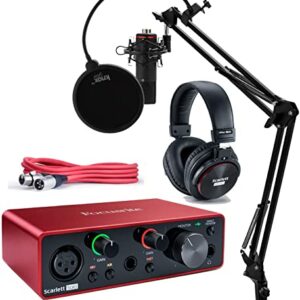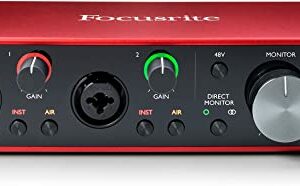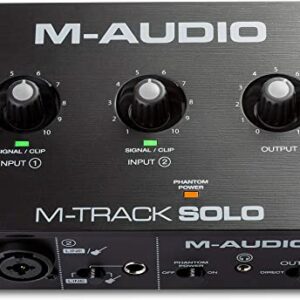PreSonus Quantum 26×32 Thunderbolt 2 Audio Interface Review (October 2024)
$719.99
Description
In this review post we’re going to be discussing the PreSonus Quantum 26×32 Thunderbolt 2 Audio Interface, including an overview of its unique features.
Product Description
PreSonus’ fastest and best-sounding audio interface; takes advantage of the recording; up to four Quantum interfaces can be stacked for higher I/O counts; expandable via ADAT Optical; integrated software control, including recallable preamps, line-level switching, output encoder control assignment, headphone routing, and talkback and monitoring options; DC-coupled analog outputs can provide control voltage to external analog equipment, controlled by a DAW plug-in; peripherals, such as hard drives and displays, can be chained via Thunderbolt; includes Studio Magic Plug-in Suite.
A great choice for a wide variety of recording environments, the 26×32-channel Quantum is PreSonus’ fastest and best-sounding audio/MIDI interface, taking advantage of the high-speed Thunderbolt 2 bus and a no-frills, direct-to-DAW (no DSP added) signal path to achieve extremely low latency. Cutting-edge 24-bit, 192 kHz converters with 120 dB of dynamic range and PreSonus’ recallable XMAX microphone preamps combine to deliver superb audio quality. For more I/O channels, simply stack up to 4 Quantum interfaces via Thunderbolt to create a monster 96×96 system. Using the included Studio One Artist DAW or UC Surface control software, you can remote-control the preamps and many other features. To top it off, Quantum owners get the Studio Magic plug-in suite free and can upgrade to Studio One Professional for 50% off.
Product Features
General Features
- 26×32 Thunderbolt ultra-low-latency audio interface
- PreSonus®’ fastest interface; record direct to DAW (no DSP)
- Stack up to four Quantum interfaces via Thunderbolt for a monster system
- Talkback switch and internal Talkback microphone
- Mute/Dim and Mono switches
- Assignable output level control
- 10 8-segment LED meters (8 input, 2 output)
Integrated Software
- Tight integration with included Studio One® Artist DAW software (macOS®/Windows®) for multitrack music production and studio command features
- Wireless control over preamp levels from free UC Surface touch-control software for iPad® and Android™ tablet and from free Studio One Remote for iPad and Android tablet
- Wired control over preamp levels from free UC Surface touch-control software for Mac® and Windows computers
- Compatible with most recording software for macOS and Windows
- Studio Magic Software Suite included
- Ableton® Live Lite included
Flexible Connectivity
- Simultaneous I/O up to 26 inputs/32 outputs (at 44.1 or 48 kHz)
- 2 front-panel combo microphone/instrument/line inputs
- 6 rear-panel combo microphone/line-level inputs
- 8 XMAX remote-controllable, Class A mic preamps with individually switched 48V phantom power
- 2 balanced ¼-inch TRS line-level main outputs
- 8 balanced ¼-inch TRS line-level outputs
- Line outputs are DC coupled for sending control voltages for analog gear
- ADAT Optical/Dual SMUX inputs/outputs: 16×16 channels at 44.1 or 48 kHz; 8×8 channels at 88.2 or 96 kHz
- Stereo S/PDIF coaxial input and output
- 2 high-volume headphone outputs with dedicated volume controls
Digitalia
- Thunderbolt 2 high-speed bus (Thunderbolt 3 compatible)
- 24-bit resolution and up to 192 kHz sampling rate
- Top-quality 120 dB A/D/A converters
- BNC word clock input and output with low-jitter clocking
- MIDI I/O on 5-pin DIN connectors
Physical
-
- Road-rugged construction with all-metal chassis and metal knobs
- 1U rack-mountable
- 12 VDC external power supply (included)
Pros & Cons
Pros
- Solid build quality
- Very trusted
- Favorable customer feedback
- Value for money
- Fantastic sound quality
Cons
- No internal DSP
- Quite Expensive
- No direct monitoring
PreSonus Quantum 26×32 Thunderbolt 2 Audio Interface Demo
Our Verdict
PreSonus made a daring step by foregoing the built-in mixer in order to focus on low-latency functioning, and in my opinion, it was the correct one. With the exception of PCIe cards, they’ve reached low-latency performance that is currently unequaled by any interface I’m aware of, so if you have a computer new enough to support Thunderbolt 2 ports, you’ll almost certainly have no need for monitoring solutions. There can be no better way to reply to the criticism leveled about Studio 192 than to create an interface that inherits all of that product’s many positive attributes while eliminating all of its flaws in one fell swoop. Bravo.
The Quantum from PreSonus combines unequaled low-latency performance and ease of use with excellent sound quality and unlimited expansion potential. In a nutshell, it’s fantastic!
Where to Buy
The best place to buy this product has to be Amazon, due to their competitive pricing and fantastic customer service.
PreSonus Quantum 26x32 Thunderbolt Audio Interface/Studio Command Center
$719.99
Pricing History
Price History for PreSonus Quantum 26x32 Thunderbolt Audio Interface/Studio Command Center
Statistics
| Current Price | $719.99 | October 14, 2024 |
| Highest Price | $999.95 | July 8, 2023 |
| Lowest Price | $719.99 | November 16, 2023 |
Last price changes
| $719.99 | November 16, 2023 |
| $899.99 | October 10, 2023 |
| $899.96 | August 16, 2023 |
| $999.95 | July 8, 2023 |
Buyers Guides This Product Is Featured In
Best Audio Interfaces Under $1000
Best 8 Channel Audio Interfaces (2022)
Best Thunderbolt Audio Interfaces (2022)
Best Low Latency Audio Interfaces (2022)
Additional information
| Item Weight | 6 pounds |
|---|---|
| Product Dimensions | 7 x 19 x 1.75 inches |
| Item model number | QUANTUM |
| Is Discontinued By Manufacturer | No |
| Date First Available | April 26, 2017 |
| Color Name | Black |
| Size | 26×32 – 8 Mic Pres |
| Standing screen display size | 1 |
Related products
-

Arturia MiniFuse 2 USB-C Audio Interface Review (October 2024)
$127.75 -

Focusrite Scarlett Solo Studio 3rd Gen Bundle Review (October 2024)
$9,999.00 -
Sale!

Focusrite Scarlett 2i2 3rd Gen Audio Interface Review (October 2024)
$152.95$119.99 -

M-Audio M-Track Solo USB Audio Interface Review (October 2024)
$49.00


Reviews
There are no reviews yet.